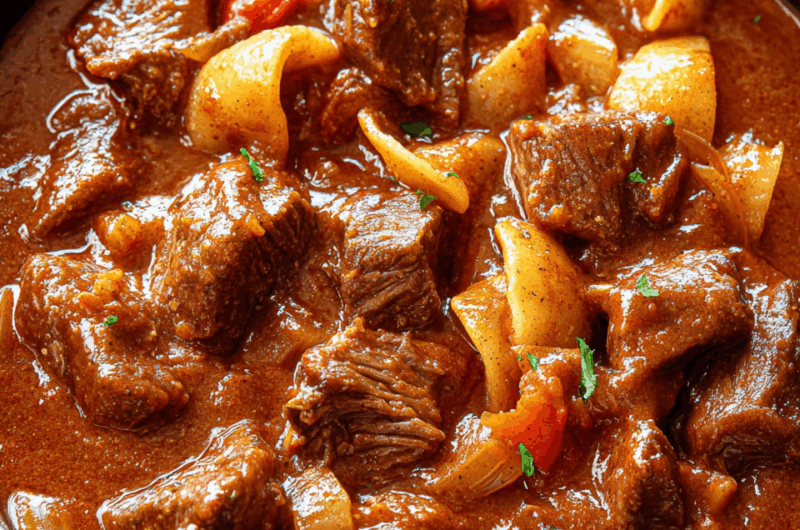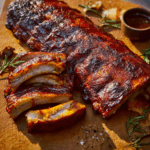This Hungarian Goulash is a warm, comforting stew, perfect for a chilly evening. The tender beef and rich paprika come together in a flavorful broth that’s perfect for dipping crusty bread into. The soft potatoes and vibrant bell peppers add texture and color, making this dish not only delicious but visually appealing.
Hungarian Goulash is a dish that’s easy to make and versatile enough to be served for any occasion. Whether you’re enjoying a cozy dinner at home or sharing a hearty meal with family and friends, this dish is sure to impress with its bold flavors and satisfying ingredients. Plus, it’s a great option for meal prep, making it perfect for lunches or future dinners.
Full Recipe:
-
2 tablespoons olive oil
-
1 lb beef chuck, cut into cubes
-
1 large onion, chopped
-
3 cloves garlic, minced
-
1 tablespoon paprika
-
1 teaspoon caraway seeds
-
2 cups beef broth
-
2 medium potatoes, peeled and diced
-
1 red bell pepper, chopped
-
1 tablespoon tomato paste
-
Salt and pepper to taste
-
Fresh parsley, chopped (for garnish)
Directions:
-
Heat olive oil in a large pot over medium heat.
-
Add the beef and brown it on all sides, about 6-8 minutes.
-
Add the onions and garlic, and cook until softened, about 5 minutes.
-
Stir in the paprika and caraway seeds, and cook for another minute.
-
Add the beef broth, potatoes, and bell pepper. Stir in the tomato paste and season with salt and pepper.
-
Bring the mixture to a simmer, cover, and let cook for about 1 hour or until the beef is tender and the potatoes are cooked through.
-
Adjust seasoning with salt and pepper if needed.
-
Serve hot, garnished with fresh parsley.
Prep Time: 10 minutes | Cooking Time: 1 hour | Total Time: 1 hour 10 minutes
Kcal: 350 kcal | Servings: 4 servings
Introduction to Hungarian Goulash
Hungarian Goulash, or “Gulyás,” is a dish that epitomizes the essence of comfort food. Known for its rich flavors and hearty ingredients, it is a classic staple in Hungarian cuisine. The dish traces its roots back centuries, originating from the nomadic shepherds of Hungary, who would cook a simple stew over an open fire. Over time, the recipe evolved to incorporate spices like paprika, which has since become synonymous with the dish. Today, Hungarian Goulash is enjoyed worldwide and can be found in countless variations, but its core elements remain the same: tender beef, flavorful paprika, and a delicious broth that is nothing short of soul-warming.
The History of Hungarian Goulash
The history of Hungarian Goulash is deeply entwined with Hungary’s cultural and culinary evolution. Originally, the dish was prepared by Hungarian herders and shepherds. They would cook a mixture of meat, vegetables, and water in large cauldrons, utilizing whatever ingredients were available. The most important ingredient in early versions of goulash was beef, a meat that was abundant in Hungary, and it was typically seasoned with salt, pepper, and a handful of herbs.
As time went on, the influence of Hungarian paprika (a spice made from dried and ground peppers) became more pronounced. Introduced to Hungary in the 16th century from the Americas, paprika became the key flavoring agent in goulash, adding a deep, smoky flavor that defines the dish today. By the 19th century, Hungarian Goulash had transitioned from a humble peasant meal to a dish celebrated across the country, often served at large gatherings, festivals, and celebrations.
Why Hungarian Goulash is So Popular
One of the reasons Hungarian Goulash continues to be so popular is its versatility and the deep, comforting flavors it offers. The dish can be served in many different ways, depending on regional variations or personal preferences. Some versions of goulash are more soupy, while others are thicker and more stew-like. Whether served with a dollop of sour cream, alongside crusty bread, or simply enjoyed on its own, Hungarian Goulash is a meal that brings people together.
Another reason for its continued popularity is its simplicity. Despite its rich flavors, the dish requires relatively few ingredients, making it easy to prepare even for beginners. It’s also a one-pot dish, meaning less cleanup and more time to enjoy the meal. This ease of preparation combined with the hearty, satisfying nature of the dish has earned it a permanent spot in home kitchens around the world.
How to Make Hungarian Goulash
Making Hungarian Goulash is a straightforward process, but there are a few tips that can elevate the dish to perfection. The key to a great goulash is using high-quality beef, as the beef should be tender and rich in flavor. It’s best to use cuts like beef chuck or stew meat, which become incredibly tender when simmered for long periods of time. The beef should be browned before simmering to create a rich base of flavor.
Another crucial aspect is paprika. To truly capture the authentic taste of Hungarian Goulash, it’s important to use Hungarian paprika, which has a unique smoky and slightly sweet flavor. Regular paprika might not provide the same depth of taste. Additionally, the choice of paprika (sweet, hot, or smoked) will determine the heat and flavor profile of your goulash, so it’s important to adjust the amount based on personal preference.
The long, slow simmer is essential for the success of the dish. This slow cooking process allows the beef to absorb the flavors of the broth, while the potatoes and peppers become tender and flavorful. The broth itself should be rich and savory, and the vegetables—such as potatoes, onions, and bell peppers—add both texture and sweetness, balancing the savory flavors of the beef and paprika.
Regional Variations of Goulash
While the core recipe for Hungarian Goulash is fairly consistent, there are many regional variations that showcase the adaptability of this dish. In some parts of Hungary, for example, goulash is served as a soup, with more broth and fewer solid ingredients. In contrast, other variations might include extra vegetables or even noodles to make the dish even heartier.
In Transylvania, goulash is often prepared with pork, while in other regions, lamb might be the preferred meat. Additionally, some people add different spices or herbs to customize the flavor further, such as bay leaves, thyme, or even caraway seeds, which are often associated with Hungarian cuisine.
One of the most famous variants is “Pörkölt,” which is similar to goulash but typically made without potatoes, and the beef is often cooked for a longer time, resulting in a more concentrated and thicker sauce. Whether you stick to the traditional version or experiment with different twists, the beauty of Hungarian Goulash lies in its adaptability to various tastes and preferences.
Pairing Hungarian Goulash with Side Dishes
Hungarian Goulash is best enjoyed with sides that complement its rich flavors. A classic accompaniment is crusty, rustic bread—perfect for soaking up the flavorful broth. Hungarian rye bread or a hearty baguette are both great options.
If you want to make the meal a bit more substantial, consider serving it with spaetzle (small egg noodles), which will absorb the sauce beautifully. In Hungary, it is common to serve goulash with “langos,” a type of deep-fried flatbread. Alternatively, you could pair it with a simple green salad dressed with vinegar and oil to balance the richness of the stew.
For a more traditional Hungarian approach, try serving your goulash with a dollop of sour cream, which adds creaminess and a slight tang to the dish. This addition brings out the flavors and makes each bite even more satisfying.
Nutritional Benefits of Hungarian Goulash
While Hungarian Goulash is a hearty and filling dish, it also provides a variety of essential nutrients. The beef provides a great source of protein, iron, and zinc, all of which are crucial for overall health. The potatoes in the dish add fiber, vitamin C, and potassium, while the bell peppers contribute antioxidants, such as vitamin A and C. The addition of paprika provides a range of health benefits as well, including anti-inflammatory properties and the potential to boost metabolism.
When prepared with lean beef and served with a side of vegetables, Hungarian Goulash can fit into a balanced diet. If you’re looking to make a lighter version, you can reduce the amount of beef or use a leaner cut, or add more vegetables to increase the fiber content.
Tips for Perfect Hungarian Goulash
To make sure your Hungarian Goulash turns out perfect every time, here are a few helpful tips:
-
Don’t skip the browning step: Browning the beef first develops a deep, rich flavor. It’s worth taking the time to sear the meat well.
-
Use quality paprika: For an authentic taste, make sure to use Hungarian paprika. You can find it online or in specialty stores. Smoked paprika will give the dish a nice depth of flavor.
-
Simmer low and slow: The longer the goulash simmers, the more flavorful it will be. Let it cook on low heat for at least an hour to ensure the beef becomes tender and the flavors meld together.
-
Adjust seasoning to taste: Don’t be afraid to taste and adjust the seasoning as it cooks. Every batch of goulash is different, and small tweaks can make a big difference.
Conclusion
Hungarian Goulash is more than just a meal; it’s a culinary tradition that brings people together around the table. Its rich, smoky flavor, tender beef, and satisfying vegetables make it a perfect dish for any occasion, whether you’re hosting a family dinner or preparing a meal for a gathering. With its long history, versatility, and comforting qualities, Hungarian Goulash will remain a beloved dish for generations to come. Give it a try, and you’ll soon see why this hearty stew has captured the hearts and taste buds of people all over the world.








